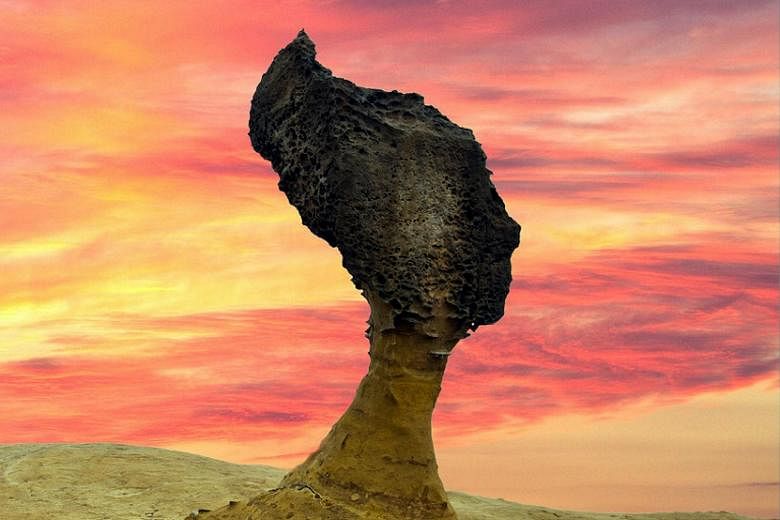YEHLIU (Taiwan) • Scientists are battling to save Taiwan's ancient Queen's Head rock from erosion, but the island is split over whether technology should be used to preserve the natural masterpiece.
More than three million people visit the coastal landmark in northern Yehliu each year, named for its supposed likeness to England's Queen Elizabeth I.
The tilting "head" is an imposing sweep of sandstone which mushrooms out of a slender stem. Honed by sea water and strong winds, the head tapers up to a point, likened to the piled-up curls of the eponymous royal. But at 4,000 years old, it may soon topple as a result of exposure to the elements.
"The neck may become too thin to support the head and might break off within the next five to 10 years, if nothing is done," warns Professor Hsieh Kuo-huang of the Institute of Polymer Science and Engineering, National Taiwan University.
"Any strong earthquakes or severe typhoons may bring down the rock formation," said Prof Hsieh, who is one of the scientists studying how to preserve the rock.
Researchers say the neck's circumference is shrinking by 1.5cm to 1.6cm each year, making it harder to support the 1.3-tonne head.
"The shape of Queen's Head today looks most elegant," says Ms Helena Tang of Neo-Space International which manages the geopark where the rock stands. "But sadly, there's not much time left."
Prof Hsieh's team has been experimenting with ways to save the formation, which stands 8m tall from its base. Using nanotechnology, the team developed paints to protect it.
"Our analysis shows that the strength of the rock's neck could be intensified by up to three times, while the surface resistance to erosion could be enhanced markedly," Prof Hsieh said.
So far the paint has been applied to surrounding rocks, rather than to the Queen's Head itself, but initial tests in August were unsuccessful as the paint peeled off. Since then, the ingredients have been tweaked and applied to other rocks in the geopark, Prof Hsieh said.
But while scientists rack their brains for a solution, others feel nature should be left to take its course.
"As the coastal landscape was made by erosion, the lifespan of the Queen's Head is limited," said Mr Pan Han-sheng, an activist from the pro-environment Tree Party.
"I don't understand why we would want to freeze its lifespan."
The geopark conducted a survey of 1,200 people randomly picked across the island before going ahead with the paint tests.
Only 63 per cent backed the scientific experiments and the survey sparked alternative less invasive suggestions, including encasing the formation in a glass cabinet.
"I would prefer a glass cabinet so that the rock can be sheltered from erosion," said Mr Kin Kuoyen, a tourist from China's Hangzhou city.
Neo-Space International has used 3D technology to record the measurements of the rock twice each year so it can be reproduced.
One replica already stands at the entrance to the park and has become a tourist attraction in itself.
Park administrator Kuo Chen- ling played down fears over the rock breaking down.
"Even in the worst scenario, a toppled Queen's Head could be placed in a museum and attract tourists," he said, adding that there were other rocks in the park which drew visitors, including some in the shape of an elephant, a shoe and a peanut.
AGENCE FRANCE-PRESSE

